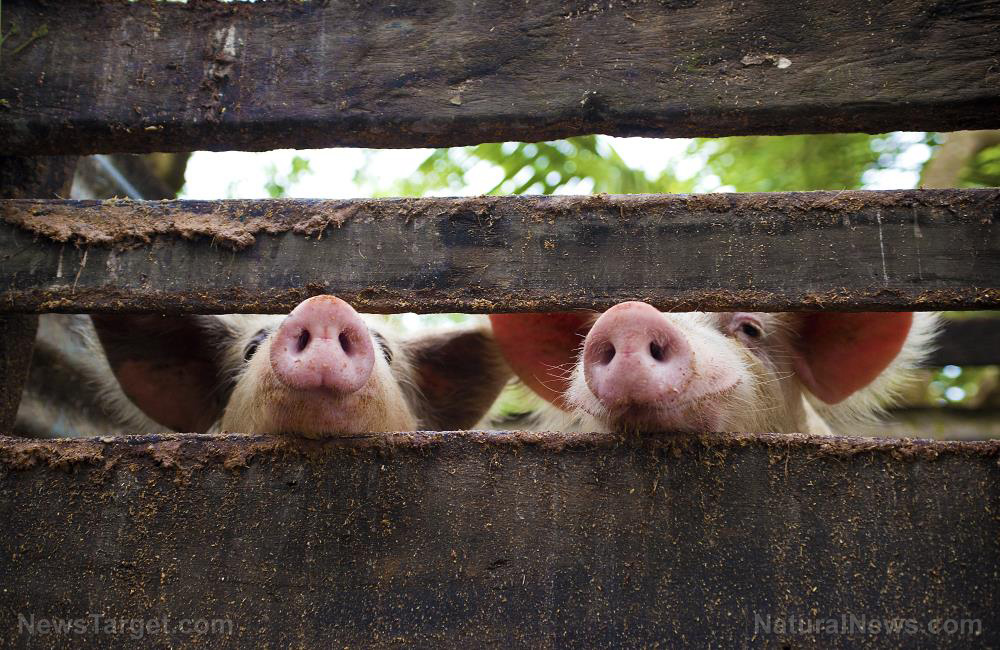Chlorine dioxide found to halt African swine fever virus: STUDY
07/25/2023 / By Ethan Huff

Chinese researchers published a study in the Frontiers journal Veterinary Infectious Diseases showing that miracle mineral supplement (MMS), also known as chlorine dioxide, is a powerful remedy against the African swine fever (ASF) virus, which is one of the most feared epidemic diseases of the pig industry worldwide.
A highly contagious illness that “provokes severe economic losses and health threats,” according to the study, ASF appears to be no match for chlorine dioxide, which neutralizes it by blocking certain viral attachments and destroying the viral nucleic acids and proteins that make it a serious threat.
The official story is that there is no known remedy or treatment for ASF. The governments of the world claim there are no vaccines or pharmaceutical drugs that can kill it, which to them means there is “no cure.”
According to the study, ASF is highly contagious, presenting extremely high morbidity and mortality rates. It also exhibits extreme resilience to high and low temperatures, and can spread easily through a variety of vectors in all sorts of climate conditions.
The disease was first described in Kenya back in the 1920s when the first outbreaks were reported. Since that time, ASF outbreaks have spread outside the borders of Africa, and now exist in the Caucasus region of Eurasia via the Republic of Georgia.
ASF is also problematic in Russia, Ukraine, and Belarus, with additional outbreaks being reported in recent years in China and other Asian countries. The societal cost of ASF is enormous, which is why a cure for it is so desperately needed.

The really great news is that there is a remedy for ASF that is both safe and effective, and it is known as chlorine dioxide.
“Chlorine dioxide (ClO2), an ideal biocide, has broad-spectrum antibacterial activity and no drug resistance,” the paper explains.
“Chlorine dioxide (ClO2), a strong oxidant, has a wide application prospect in different fields such as food and environment disinfection, medicine, as well as wastewater or water treatment.”
For the purposes of the study, Chinese researchers looked closely at the mechanisms through which chlorine dioxide works its magic. A description of what they found reads as follows:
“Here, we found that ClO2 strongly inhibited ASFV replication in porcine alveolar macrophages (PAMs). The inhibitory effect of ClO2 occurred during viral attachment rather than entry, indicating that ClO2 suppressed the early stage of virus life cycle. ClO2 showed a potent anti-ASFV effect when added either before, simultaneously with, or after virus infection.”
(Related: Did you know that chlorine dioxide also destroys atrazine, a gender-bender herbicide sprayed on food crops that is ever-present in America’s water supplies?)
Will U.S. authorities ever considering using chlorine dioxide in domestic pigs?
The paper goes on to explain in detail how ClO2 destroys viral nucleic acids and proteins, which could explain why it so powerfully inactivates and puts a stop to ASFV virions.
“The minimum concentration of degradation of ASFV nucleic acids by ClO2 is 1.2 ?g / mL, and the degradation is a temperature-dependent manner,” the paper goes on to reveal.
“These have guiding significance for ClO2 prevention and control of ASFV infection in pig farms. In addition, ClO2 decreased the expression of ASFV-induced inflammatory cytokines. Overall, our findings suggest that ClO2 may be an ideal candidate for the development of novel anti-ASFV prophylactic and therapeutic drugs in swine industry.”
Seeing as how 60 percent of global pig production takes place in China, these findings by Chinese researchers are promising for that country’s swine industry. One wonders if United States authorities will take note of these findings as well and protect our own domestic herds from a potential ASF outbreak and epidemic?
Interested in learning more about natural solutions to disease? Check out Cures.news.
Sources for this article include:
Submit a correction >>
Tagged Under:
african swine fever virus, agriculture, alternative medicine, antiviral, breakthrough, chlorine dioxide, Cures, discoveries, epidemic, infection, outbreak, pigs, prevention, remedies, research, virus
This article may contain statements that reflect the opinion of the author




















